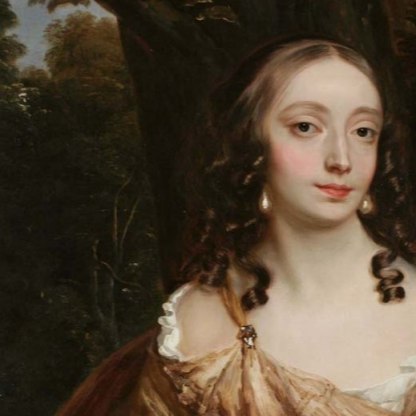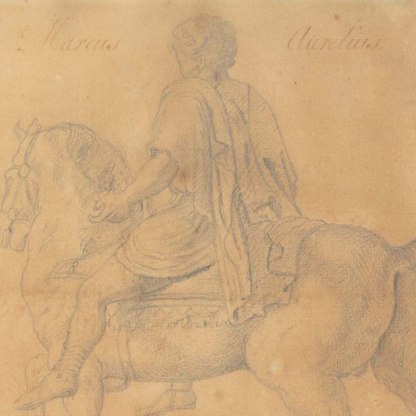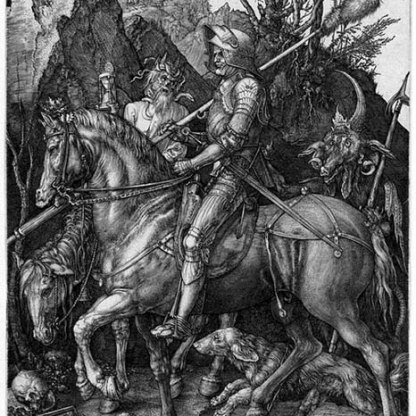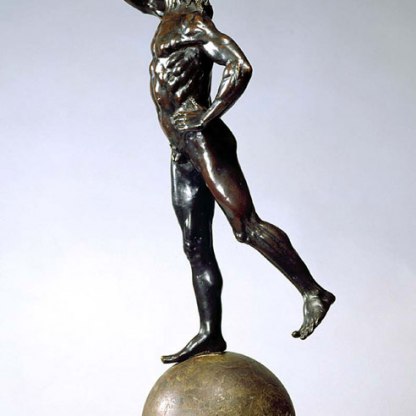Rider on a Rearing Horse

The Fitzwilliam owns two drawings of horses and riders by Leonardo da Vinci, both done on paper so similar that they are likely to have been cut from the same sheet. You can see the other one on the right [PD.121-1961]. They are probably preparatory sketches for an altarpiece depicting the Adoration of the Magi, planned for the church of San Donato in Florence.
This was never completed, but the unfinished panel can be seen today in the Uffizi, Florence (left). Several horses in a variety of postures are visible in the background, including one rearing up to the right, bearing a rider, as on the Fitzwilliam sheet.
Throughout his life, Leonardo seems to have had a personal fascination with the horse and he is known to have written a treatise on the subject, now sadly lost. Also lost is a painting of the battle of Anghiari made for the old Town Hall of Florence, but copies such as that from the Galleria dell'Academia in Venice (left) show that it contained an elaborate depiction of cavalry warfare.
There is a tremendous vigour to the Fitzwilliam's rider and his mount. The drawing has an almost centrifugal design: the horse lurches upwards and to the right, while the man turns sharply to the left, his cloak billowing behind him. Leonardo has sketched two sets of hind legs, and these suggest the blurred appearance of a horse's limbs in motion. The animal's physicality is simply but brilliantly evoked: its vivid, wild face, its muscular chest, its lean yet powerful legs.
Drawn in metalpoint – a technique in which a stylus is tipped with metal that reacts chemically with a prepared sheet of paper – the Fitzwilliam drawings, with their precise anatomy and their experiments in posture, are valuable records of an enthusiasm that stayed with Leonardo throughout his life.
In 1482, probably shortly after making this sketch, the artist wrote to offer his services to Ludovico Sforza, the powerful ruler of Milan. His letter survives, a fascinating document that highlights the extraordinary breadth of the young Leonardo's interests and fields of expertise.
Though he is probably best known today as the creator of the Mona Lisa and The Last Supper, painting actually came comparatively low on the list of the skills that Leonardo put at Ludovico's disposal. In an Italy divided into small city-states, each vying for dominance, the techniques and machines of warfare were of paramount importance and it was chiefly as an engineer that Leonardo sought employment. He offered Ludovico siege equipment, cannons, tunnels, ships that will not burn, armoured cars 'and other engines of wonderful efficacy not in general use'.
'Moreover' he added, 'I would undertake the work of the bronze horse, which shall perpetuate with immortal glory and eternal honour, the auspicious memory of the Prince your father and of the illustrious house of Sforza.'
A huge bronze of a rearing horse with a rider, treading down an enemy, was indeed commissioned by Ludovico to commemorate the life of his father, Francesco, one of the most successful condottieri – mercenaries – of fifteenth-century Italy. Several of Leonardo's preparatory sketches for this survive, and an image of the terracotta model made for the monument survives on a coin in the Fitzwilliam.
In the end, the bronze that had been set aside for the great horse was used to make cannon, and Leonardo's model became the object of target practice by invading French troops in 1499. The ambitious project was never completed in his lifetime, but on 10 September 1999 a bronze horse based upon Leonardo's designs was unveiled in a public park in Milan.
Themes and periods
Data from our collections database
Sir Peter Lely (Lugt 2092); the Earls of Pembroke; Pembroke Sale, Sotheby's, 10 July 1917, lot 467; Henry Oppenheimer, his sale, Christie's, 10-14 July 1936, lot 106; bought by P. & D. Colnaghi & Co. for Captain Norman Colville, M.C.
Legal notes
Acquired from the Trustees of Colonel Norman R. Colville, deceased, by Private Treaty Sale from the Gow, Cunliffe, Leverton Harris, Perrins and Reitlinger funds, with a contribution from The Art Fund, The National Lottery through the Heritage Lottery Fund and a grant from the Pilgrim Trust, with contributions from Mrs Monica Beck, David Scrase and an anonymous donor, 1999
Acquisition and important dates
- Method of acquisition: Bought
- Dates: 1999
Dating
- 1480s
- Production date: not before AD 1481
Maker(s)
Materials used in production
Read more about this recordStories, Contexts and Themes
Other highlight objects you might like
Suggested Curating Cambridge products
Sign up to our emails
Be the first to hear about our news, exhibitions, events and more…







